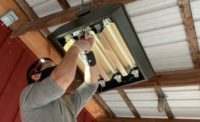Royal Wine’s food processing and distribution center authorities responded to employee wintertime requests for a warmer shipping area. In the process, they received a bonus when the six dock door air curtains appropriated for air comfort also reduced operational energy costs.
Sub-freezing days near open shipping doors previously required heavy clothing, hampered worker productivity, and caused chilling air drafts regardless of portable truck and dock seals, according to Abraham Wechter, plant engineer at Royal Wine Corp. (Bayonne, NJ).
Royal Wine, a kosher winemaker, imports and produces more than 60 brands of wine and manufactures the Kedem fruit juices brand. The company also operates Herzog Wine Cellars with vineyards in Oxnard, CA.
Charles Cino, sales engineer at manufacturer representative SRS Enterprises (Middletown, NJ) and Wechter collaborated on shipping door options. Cino assessed the application for separating the outdoor from indoor environments during the dozens of daily shipping door cycles. He then submitted an air curtain equipment type and sizing strategy based on a consultation with Stephen Benes, sales manager at Berner International. Miller Mechanical Corp. (Sayreville, NJ) was the installation contractor.
Consequently, employees now work in a warm, comfortable environment, but equally important are the energy savings. Modeling one door’s energy savings using the Berner Energy Savings Calculator, available at www.berner.com, predicted energy savings of $3,532.97 (630-Mbtu) annually for one door open an average of 24-hours weekly. Multiplying those savings by six doors totals an estimated annual savings of $21,197.82. The user-friendly calculator automatically links location-specific National Weather Bin and local utility rates data, based on zip code.
Cino selected six Berner Industrial Direct Drive, model IDC-12 air curtains with indirect gas-fired heat for the 8-ft by 10-ft roll-up door openings. Each air curtain incorporates three .50-hp, single-speed dual-shaft motors that drive blower wheel assemblies delivering 4,443 cfm. The result is a laminar air stream that returns 70% to 80% of the indoor energy back into the space while blocking outdoor temperature infiltration.
Wechter and Cino also selected supplementary heat options for the air curtain retrofits to maintain shipping area temperatures at 70°F, regardless of outdoor temperatures and open door time duration. Berner International supplied one 200-Mbh indirect gas-fired unit heater per air curtain, delivering a 32°F temperature rise to the air stream. Berner’s custom metal shop also fabricated, powder-coated, and factory-attached a 14-ga aluminized steel duct plenum transition to the air curtain inlet that aesthetically matches each unit heater. Thus, the unit heater discharges heat toward the plenum and each air curtain draws it through for uniform distribution.
The heat option helps supplement Royal Wine’s existing multiple installations of unit heaters by Reznor/Nortek Global Ltd. and infrared heaters by Detroit Radiant Re-Verber-Ray®. Also helpful in moving static heat from the ceiling are High Volume/Low Speed (HVLS) fans by Rite-Hite Corp.
Typically, many industrial shipping door air curtains incorporate internal hot water, steam or electric coils for area heating. However, the gas unit heater/air curtain arrangement Cino selected was the best option because the gas service was nearby and cost effective to operate.
Each air curtain’s control package includes a factory-mounted and wired UL-listed motor control panel, complete with a rotary non-fused disconnect switch, time delay relay, 24V transformer, and a remote-mounted hand off/auto–summer-winter combination switch and thermostat. The air curtains are activated through a 24V heavy-duty, floor-mounted magnetic reed switch that activates the air curtain when the overhead roll up/canister doors go up. The heaters are activated by a thermostat.
Royal Wine plans to keep the air curtains activated year-round because the plant uses several 20-ton rooftop HVAC units manufactured by York to maintain temperatures for optimum wine/juice storage. In addition to stable temperatures, summertime door protection will help eliminate flying insect and dust infiltration, an important sanitation factor for juice and wine facilities.
Miller Mechanical suspended the air curtains, the factory-mounted duct transition, and the independently supported gas unit heaters from the 25-ft-high ceiling with threaded rod. Stabilization bars were also used to effectively maintain distance away from the wall so that the downward air stream isn’t obstructed by the roll-up door mechanism canister. The IDC12 air curtain’s adjustable twin aluminum airfoil-shaped turning vanes ±20-degree capacity were field-adjusted +15-degrees so the air stream meets the floor just outside the threshold.
Wechter is satisfied with the air curtain performance and energy savings, and he plans to order another IDC12 for a remotely-located shipping door.




